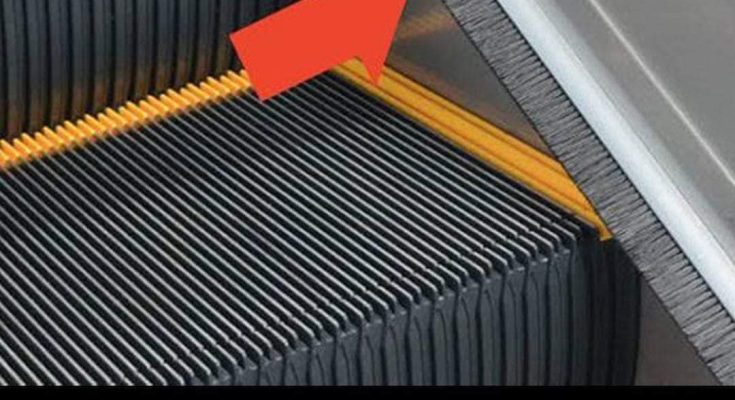Let’s take a deeper look into this fascinating aspect of escalator design and understand how these grooves play a vital role in keeping millions of passengers safe every day.
Why Are Escalator Steps Grooved?
At first glance, the grooves on escalator steps might seem to be there for traction, offering a slip-resistant surface. While this is partially true, their primary purpose goes beyond that. These grooves are key to the mechanical and safety features of escalators, making them an indispensable part of their design.
Ensuring a Smooth Transition with the Comb Plate
One of the most important functions of these grooves is to facilitate a seamless transition between the escalator steps and the comb plate—a comb-like structure located at the top and bottom of the escalator. This alignment ensures:
-
- Prevention of Item Entrapment
The grooves help reduce the risk of small objects, such as shoes, bags, or loose clothing, getting trapped between the moving steps and the stationary plate.
- Prevention of Item Entrapment
- Operational Safety
Without the grooves, foreign objects could easily jam the machinery, potentially causing dangerous malfunctions or halting the escalator altogether. By fitting into the comb plate like puzzle pieces, the grooves ensure smooth operation and enhanced passenger safety.
Managing Spills and Preventing Slips
Escalators in busy environments, like malls and airports, are often exposed to spills. Drinks, water, or other liquids can accumulate on the steps, creating a slippery surface. The grooves on the steps serve as a drainage system, channeling the liquid away and reducing the chances of pooling. This design helps minimize slip risks, particularly in high-traffic areas.
How the Grooved Steps Work with the Comb Plate
The interaction between the grooved steps and the comb plate showcases remarkable engineering precision. The grooves ensure the steps retract and extend smoothly during their cyclical movement, maintaining both functionality and safety.
Preventing Debris Build-Up
Imagine an escalator without grooves. Small items like coins, dirt, or shoelaces could easily get lodged in the gap between the step and the landing platform. This not only risks damaging the escalator but also poses a serious safety hazard for passengers. The grooves, paired with the comb plate, eliminate this risk, keeping the escalator running smoothly and safely.
Safety Brushes: The Unsung Heroes
While grooves address issues on the horizontal plane, safety brushes focus on the vertical edges of the escalator. These small brushes, located along the sides of the steps, might seem insignificant but are essential to preventing accidents.
Protection Against Snagging
Safety brushes are strategically placed to prevent items like long coats, scarves, or shoelaces from getting caught between the moving steps and the escalator’s skirt panel—the sides of the machine.
Encouraging Reflexive Safety
Interestingly, these brushes serve a psychological purpose as well. When passengers feel the soft bristles against their legs or belongings, they instinctively move away from the edges, reducing the chances of snagging or entrapment.
Meeting Modern Safety Standards
In recognition of their importance, safety brushes became a mandatory feature in escalators across Europe and the UK in 2004. Today, they are a standard safety feature worldwide, reinforcing their role in protecting passengers.
The Bigger Picture: Why Grooves and Brushes Matter
Escalators are used by millions of people every day, making their safety features non-negotiable. The grooves and brushes, though small design elements, collectively play a significant role in ensuring passenger safety and operational efficiency.
Preventing Accidents
Without grooves, items could easily become lodged in the machinery, leading to abrupt stops, tripping hazards, or even severe injuries. The grooves act as a safeguard, preventing these issues before they occur.
Supporting Smooth Operation
Similarly, the safety brushes prevent clothing or other objects from interfering with the escalator’s moving parts. Together, these features maintain a seamless and safe riding experience for all passengers.
Appreciating the Thoughtful Design
Escalators might seem like a straightforward invention, but their design involves meticulous engineering. The grooves on the steps align perfectly with the comb plate to ensure smooth transitions, while the safety brushes protect passengers from potential hazards. These seemingly minor details combine to create a machine that is both efficient and safe.
Next Time, Take a Closer Look
The next time you ride an escalator, take a moment to notice its grooves and safety brushes. These small but critical features are more than just part of the design—they represent thoughtful engineering that prioritizes your safety.
From managing spills to preventing mechanical jams, every element of an escalator is carefully crafted to meet the highest safety standards. It’s a testament to how even the smallest details can make a big difference.
Conclusion: Small Details, Big Impact
The grooves on escalator steps are much more than a design choice—they are an essential safety feature. Paired with safety brushes, these grooves ensure smooth operation, prevent accidents, and keep millions of riders safe every day.
So, the next time you step onto an escalator, remember the ingenuity behind its design. It’s the small, often-overlooked details that make escalators one of the safest and most reliable transportation tools in public spaces.V



